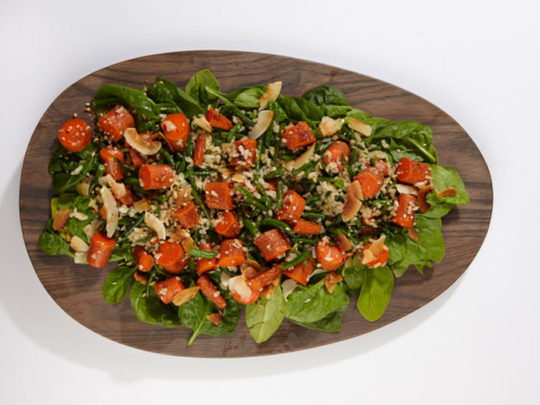
An interviewer asked me recently how I make vegetarian cooking appealing to carnivores. The first step, of course, is to use vegetables that are as fresh as possible — in season, preferably locally grown — so they have the most flavour. But also on the list is my frequent use of global spice blends: Middle Eastern za’atar, Chinese five-spice, Indian masalas and one of my more recent favourites, Egyptian dukkah.
Dukkah is actually a blend of spices and nuts, which allows it to play the part of a condiment, too. Traditionally, it’s used as a dip with olive oil and bread, but I most frequently find myself sprinkling it on to roasted vegetables: before they go in the oven if they’re going to be quick (or if I don’t mind some serious toasting of the spice mix), or afterwards, if I want something a little fresher tasting.
As with other spice mixes, you’ll find it in many varieties, using different nuts and even, in the case of my favourite version made by Boston-area chef Ana Sortun, with coconut flakes included.
There’s a recipe for Sortun’s version in her lovely 2006 book Spice: Flavors of the Eastern Mediterranean, but I picked up a batch from her bakery-shop Sofra in Cambridge, recently and have been ploughing through it. She pairs it in her book (and restaurants) with a carrot purée, an amazing combination, so I often think of carrots when I pull it out of my pantry.
When the weather cooled off recently, I returned to roasting, and the last time I roasted carrots, I threw in some slim green beans for the last few minutes, then tossed them with a little dukkah, leftover rice and spinach leaves for a main-course salad. Large coconut flakes played off the coconut’s presence in the dukkah, which I also used to make the dressing.
It certainly wasn’t Egyptian, but then again, neither am I.
ROASTED CARROT, GREEN BEAN AND COCONUT SALAD
2 to 3 servings
It’s worth seeking out dukkah, a crunchy, aromatic Egyptian mix of nuts and spices that brings roasted vegetables to life. Find it at online spice merchants such as Penzeys.com, Kalustyans.com and GryffonRidge.com, or make your own (see NOTE).
From Washington Post Food editor Joe Yonan, author of Eat Your Vegetables: Bold Recipes for the Single Cook (Ten Speed Press, 2013).
INGREDIENTS
450g (5 to 6 medium) carrots, scrubbed but not peeled
1 tsp extra-virgin olive oil
Sea salt
230g thin green beans, preferably haricot verts, trimmed
1/2 cup large unsweetened coconut flakes
2 tbs coconut oil (may substitute sesame or olive oil)
2 tbs white vinegar
1 tbs dukkah (Egyptian nut and spice blend; see headnote)
1 tsp honey
1 cup cooked and cooled brown rice (may substitute another grain of your choice)
2 cups lightly packed baby spinach leaves
STEPS
Preheat the oven to 450 degrees. Toss the carrots with olive oil and a generous sprinkling of salt on a rimmed baking sheet and roast until they are slightly browned and barely tender when pierced with a fork, 30 to 40 minutes. Add the green beans and coconut flakes and continue roasting until the beans start to soften and the coconut begins to brown, 5 to 10 minutes.
Remove the vegetables and coconut and let them cool, then cut the vegetables into bite-size pieces. Make the dressing by whisking together in a medium bowl the coconut oil, vinegar, 2 teaspoons of the dukkah, honey and a pinch of salt. Add the cooled vegetables, coconut and rice, and toss to combine.
To serve, divide the spinach among shallow bowls and top with the vegetable-rice mixture. Sprinkle with the remaining teaspoon of dukkah.
NOTE: Our favourite version of dukkah is an adaptation of Boston-area chef Ana Sortun’s because it includes toasted coconut. In a dry saute pan, toast 1/4 cup blanched almonds, 4 1/2 teaspoons coriander seeds, 1 tablespoon cumin seeds, 1 tablespoon white sesame seeds and 2 tablespoons unsweetened dried shredded coconut until browned and fragrant. Transfer to an electric spice grinder and coarsely grind, then stir in 1/4 teaspoon salt and 1/4 teaspoon freshly ground black pepper. Store in an airtight container for up to three months.
NUTRITION Per serving (based on 3): 340 calories, 6g protein, 42g carbohydrates, 20g fat, 15g saturated fat, 0mg cholesterol, 230mg sodium, 10g dietary fibre, 11g sugar
— Washington Post











